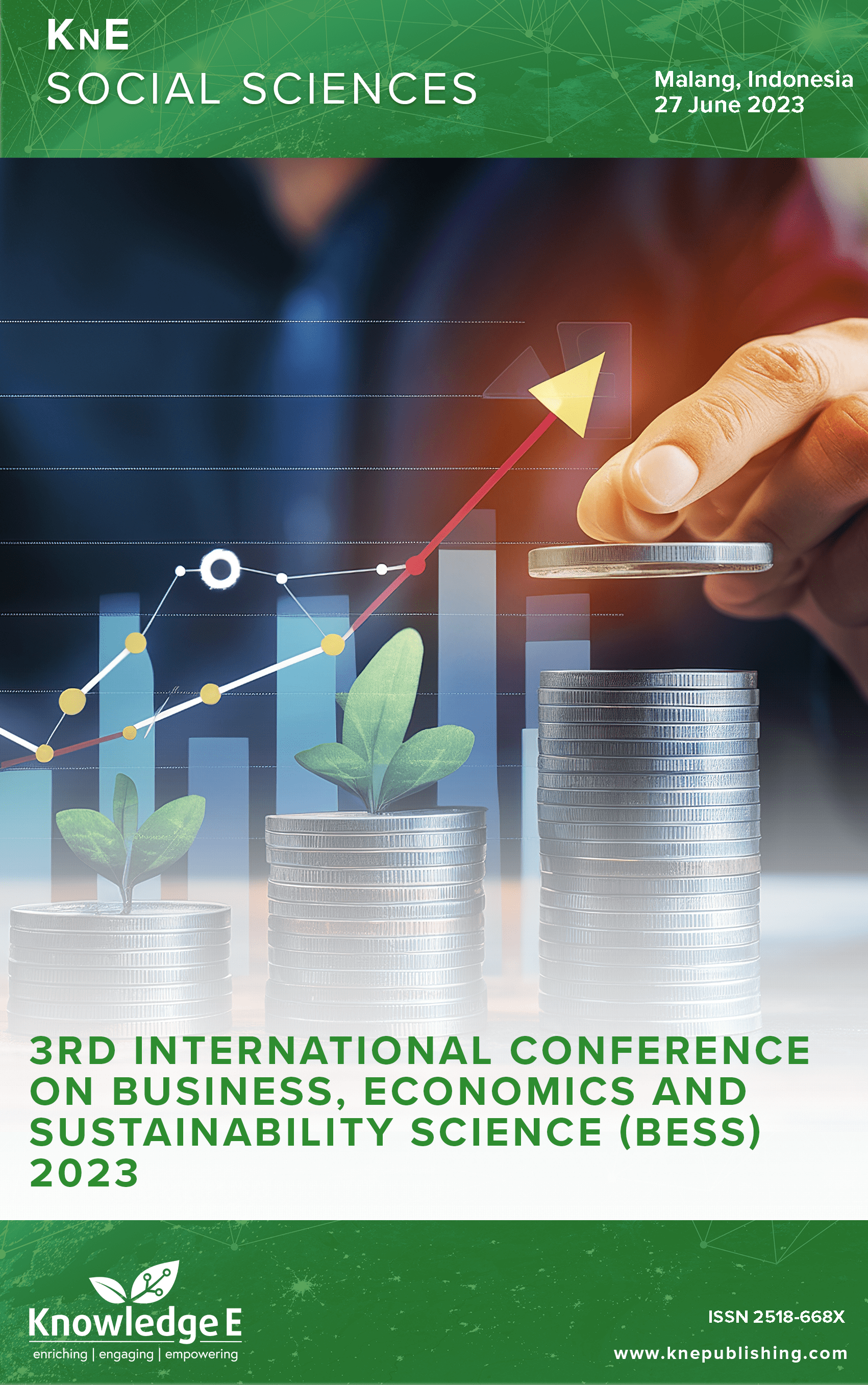The Effect of Land Area and Labor on Production of Coffee in Indonesia
DOI:
https://doi.org/10.18502/kss.v9i21.16753Abstract
Indonesia is an agricultural country where most of the population works in the agricultural sector. Therefore, the agricultural sector contributes significantly to its economic growth. This study aims to determine the effect of land area and labor production of coffee in Indonesia. The study uses secondary data. Data analysis technique in this study is multiple linear regression with data panels in 32 provinces of high production coffee in Indonesia from 2017 until 2021. Dependent variable is coffee production and the independent variables are land and labor. Results show that land area has a positive and significant effect on coffee production. It means that raising the land area significantly increases the coffee production. However, labor has a positive but not significant effect on coffee production. This study is expected to help Indonesian policy-makers for drafting policies to increase coffee production in Indonesia.
Keywords: coffee production, land area, labor, panel
References
Alamsyah, R., & Purnomo, A. (2021). Analysis of Factor Affecting Industrial Production of Robusta Coffee in Way Tenong District, West Lampung Regency. 6.
Ardiansah MR, Widjajanti A, Jumiati A. (2014). Analysis of Factors Affecting Production of Smallholder Coffee Farming in Silo District, Jember Regency. Universitas Jember Repository, 1–6. http://repository.unej.ac.id/bitstream/handle/123456789/63830/M. Risal Ardiansah.pdf?sequence=1
Dewi IA, Yuliarmi NN. (2017). The Influence of Capital, Labor, And Land Area on the Amount of Arabica Coffee production, Kintamani District, Bangli Regency. E-Jurnal EP UNUD. Universitas Udayana, 6(6), 29. https://ojs.unud.ac.id/index.php/eep/issue/view/2298
Ginting AL, Widyawati RF. Analysis of Commercial Bank Credit Distribution on Economic Growth and Employment Absorption in Indonesia. OPTIMUM: Jurnal Ekonomi Dan Pembangunan. 2022;12(1):33–40.
Hariani, E., Widyawati, R. F., & Ginting, A. L. (2022). Determinants of Carbon Emissions in 10 ASEAN Countries. 54, 313–320. DOI: https://doi.org/10.15294/edaj.v11i3.55632
Haryoko, M., Karno, & Setiadi, A. (2018). Analysis of Factors Affecting Robusta Coffee Production in Temanggung Regency (Case Study in Pringsurat District). Jurnal AGROMEDIA, 36(2), 46–54.
Kementerian Pertanian. (2021). National Leading Plantation Statistics 2019-2021. In Direktorat Jendral Perkebunan Kementerian Pertanian Republik Indonesia. Kementerian Pertanian.
Kuncoro M. The Quantitaive Method: Theory and Application to Business and Economics. 4th ed. YKPN; 2011.
Nadila I, Tridakusumah AC. Factors Affecting the Production of Arabica Coffee Farming at LMDH Kramat Jaya, Cisurupan District, Garut. Jurnal Pemikiran Masyarakat Ilmiah Berwawasan Agribisnis. 2022;8(1):18–27. DOI: https://doi.org/10.25157/ma.v8i1.5764
Nurliyah AN. (2019). Relationshio of Factor Affecting Coffee Production in South Sulawesi Province. Prosiding Seminar Nasional Sinergitas Multidisiplin Ilmu Pengetahuan Dan Teknologi, 2(Vol 2 (2019): Prosiding Seminar Nasional Kedua Sinergitas Multidisiplin Ilmu Pengetahuan dan Teknologi), 316–322. https://jurnal.yapri.ac.id/index.php/semnassmipt/article/view/82/66
Pertiwi NK, Sutrisna K. (2019). The Effect of Total Labor and Land Area on Coffee Exports and Coffee Productivity in Bali Province. E-Jurnal EP UNUD. Universitas Udayana, 10(8), 1–27. http://www.tjyybjb.ac.cn/CN/article/downloadArticleFile. do?attachType=PDF&id=9987
Prasetyo MD. (2018). Analysis of the Effect of Land Area and Labor on Coffee Production in Indonesia. uhammadiyah Malang University]. https://eprints.umm.ac.id/37144/
Putra IK, Wenagama IW. Effect of Land Area, Techonology on Production and Income Robusta Coffee Farmers in Munduk Temu Village. E-Jurnal EP Unud. 2012;9(10):2360–89.
Putri A, Yusmani Y, Paloma C, Zakir Z. Production Factor Performance of Arabica Coffee in Gumanti Valley, Solok Regency, West Sumatra. Industria: Jurnal Teknologi Dan Manajemen Agroindustri. 2018;7(3):189–97. DOI: https://doi.org/10.21776/ub.industria.2018.007.03.7
Rondhi M, Hariyanto Adi A. The Influence of Land Ownership Patterns on Production, Labor Allocation, and Rice Farming Efficiency. AGRARIS: Journal of Agribusiness and Rural Development Research. 2018;4(2): https://doi.org/10.18196/agr.4265. DOI: https://doi.org/10.18196/agr.4265
Tungga, A. A. P. (2021). Factors Influencing Coffee Production in 10 Provinces Indonesia. (Issue 1759). Universitas Katolik Parahyangan.
Widyawati RF. The Impact of International Trade Openness, Human Capital and Capital Flows on the Economic Growth of ASEAN-5 Countries in 1993-2013. Ekuilibrium: Jurnal Ilmiah Bidang Ilmu Ekonomi. 2017;14(1):58–70.
Widyawati, R. F., Ermatry, H., & Ginting, Andi Lopa; Nainggolan, E. The Influence of Economic Growth, Urban Population, International Trade Openness on Carbon Dioxide (CO2) Emissions in Asean Countries. Jambura Agribusiness Journal. 2021;3(1):37–47. DOI: https://doi.org/10.33830/isbest.v1i.612
Widyawati RF, Hariani E, Ulul Y. (2022). The Influence of Credit Risk and Liquidity Risk on Profitability of State - Owned Bank (BUMN). Jurnal Ekonomi Dan Bisnis Jagaditha, 9(2), 108–114. https://doi.org/https://doi.org/10.22225/jj.9.2.2022.108-114 DOI: https://doi.org/10.22225/jj.9.2.2022.108-114
Windiarti, R., & Kusmiati, A. (2011). Analysis of Coffee Commodity Regions in Indonesia. Jurnal Sosial Ekonomi Pertanian, 5(2), 47-58–58.
Zen F, Budiasih B. Productivity and Technical Efficiency of the Coffee Plantation Business in South Sumatra and Lampung. Jurnal Ekonomi Dan Pembangunan Indonesia. Edisi Khusus Call for Paper JEPI. 2019;2018:72–86. DOI: https://doi.org/10.21002/jepi.v0i0.1061

